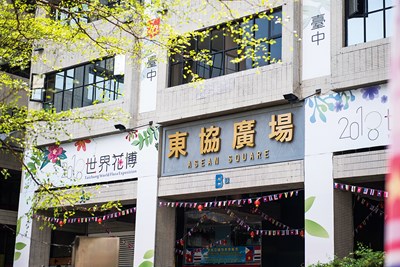
A reflection of Taichung City's history
The evolution of First Market into ASEAN Square
Sponsored by Hao Hsi
Words by Cai Jin-ding
Translated by Anna Yang
Photography by Reflection Photography
On July 3, Taichung City Government officially changed the name of First Square to ASEAN Square. Noting that this renaming symbolized Taichung's status as a friendly, multicultural city, Mayor Lin Chia-lung said that it was a "newcomer-formed society" and a city of "many cultures, like the many colors of the rainbow, which is what makes Taichung beautiful".
Before becoming First Square, today's ASEAN Square was once the site of the Taichung First Market. With its evolution alongside the city throughout its history, it is interesting to consider how much local residents really know about this continually changing neighborhood.
During the Japanese colonial era, Taichung had three main markets-Yourongding (First Market), Xinfuding (Second Market) and Yinding (Third Market)-which sold fresh and preserved seafood, poultry, vegetables, fruit and other daily necessities. All three markets played a key role in the city's consumer and public sanitation history, and none more so than First Market.
In 1907, the city government began modernizing local markets, officially opening First Market to the public the following year. In 1918, several construction projects were also launched, starting with office buildings and businesses along today's Taiwan Boulevard (formerly Yingqiao Tong). As business grew, more stores were constructed and, in 1930, final modernization projects featured a 6,174-square-meter space for market use, 1,851 square meters of building space, and a 1,071-square-meter city hall. Several businesses in this area featured entertainment centers, memorial assembly halls, theaters and photo studios, enhancing Taichung residents' quality of life. By 1934, the flourishing city's First Market had a total of 147 vendors and approximately 3,500 daily customers.
Continuing through tough time
Although Taiwan faced an economic depression following World War II, First Market continued to flourish. In this financially unstable period, prices for the market's commodities remained unchanged. However, a growing population led to the issue of insufficient market space. In 1956, city resident Lin Wu-wei filed a complaint to the media, noting, "The markets and ChengGong Road are crowded with people by 8 o'clock in the morning. First Market is disorganized with vegetable, grocery and snack vendors right next to each other. Traffic issues persist all the time and it is difficult to get through the crowds."
In 1959, the government removed the First Market's illegal vendors to improve public safety and traffic, resulting in 50 vendor owners pleading that thousands of people would lose their jobs. From this historic data, it's not hard to imagine the past prosperity of this marketplace and its surrounding area.
In fact, in 1962 the government planned to spend NT$4.2 million to expand First Market to four times its original size by turning it into a four-story building. However, this was never officially initiated and in October, 1978 a fire destroyed the market, extinguishing any expansion plans.
Charred market transforms into a plaza
Two years after the 1978 fire, Chungcheng Architecture Chairman Chou Cheng-hui won a bid to build First Square on the site of the burned-down market. However, a final agreement and land transferal for this project wouldn't be completed for over a decade.
Chou recalls, "The market was a mess after the fire. The government wanted to take back the land, yet several residents did not want to move out. When former lawyer Chang Tzu-yuan was elected mayor, he researched the illegal vendors' leases and contracts. Then, on July 15, 1987 (the same day Martial Law was lifted nationally), the government cut off the illegal vendors' water, power and gas, and asked our architecture company to surround the market with fences, finally forcing the illegal residents to leave."
Three years later, the former market site was developed into a 12-floor building with a basement. The modern building was named Wei Er Business Center, also known as Taichung First Square. The basement to the seventh floor were designated for shop spaces, and the former First Market was officially moved into the building (first to third floors) in 1993. The rest of building became residential space. However, resident businesses were not as successful as expected due to heavy transportation construction work and district development, leading a number of shops and restaurants on the basement level to close and move away.
From First Square to ASEAN Square
The 1997 establishment of the Taiwan High Speed Rail Consortium (later Corporation) led to the influx of many Thai foreign workers into the city when construction of the Taichung HSR station began in 2002. Many of them ate at First Square, due to its convenient transportation connections, and this forgotten area began flourishing once again. With the completion of the HSR station, other newcomers from Vietnam, Indonesia and the Philippines also began hanging out in this area, leading a growing number of foreign shops and restaurants owned by Southeast Asians to open here in order to cater to the daily needs of their customers.
Such shop owners include Ms. Nguyen, who today owns a Vietnamese grocery store on ASEAN Square's third floor. Pointing to her "Viet Sweets" sign, she explains, "My family in Vietnam sells desserts, but I didn't know how to make them before because my mom would make them for me. When I married and moved to Taiwan in 1995, I missed those home-cooked flavors and asked my mother for the recipes. I shared my desserts with the neighbors and they all said they tasted great, so I went and sold my desserts at Taichung Park. Then people told me there were some Vietnamese at First Square and suggested that I sell them there. Thus, I decorated my desserts with beautiful, colorful ribbons, so that they would taste as fancy as the ribbon's colors."
The coconut and glutinous rice desserts that she sells aren't easy to make. Besides offering her grandmother's sweet desserts, Ms. Nguyen also sells southern Vietnamese rice cakes. While northern Vietnam has square-shaped, salty rice cakes, the southern variety are rectangular and sweet. She laughs and says that people from the north do not eat sweet food, and that only people from the south understands the festive, sweet homemade flavors that she provides at ASEAN Square.
Unstoppable cultural changes
TToday, a prosperity god shrine is located near the entrance of ASEAN Square. Originally located in First Market's bike parking lot, it was built to honor the three earth gods but, as local business changed, the shrine was renamed "Caifudian" (prosperity god), symbolizing a life of well-being. Although Southeast Asian cultures now dominate this community, traditional Taiwanese religious practices continue here, too.
Plenty of traditional Taiwanese shops from the First Market days also remain in this area. Wanwun Foods sells dried fish floss. An original resident of First Market, the shop was forced to leave after the 1978 fire and moved to a storefront on nearby GuangFu Road. However, the same delicious flavors from earlier times are still offered here.
Famous iced dessert shop Hsinfating is another historic Taichung shop, founded in 1943 at First Market because the ice-making factory was right across the street. The market was literally established at the same time as this ice-making factory in 1907, with the ice mainly used for medical purposes and to improve public sanitation by preventing bacteria outbreaks. Originally utilized to keep food fresh, it gradually became a dessert option at Hsinfating.
Not too far from Hsinfating are other famous First Market businesses like Laopai pork thick soup and Gaojia noodles. After the 1978 fire, several tasty local eateries left the market and continued their businesses nearby. Although the market is long gone, the area's authentic Taiwanese cuisine still attracts old customers, lining up patiently to enjoy their favorites. Moreover, despite unstable financial conditions, the fabric stores on JiGuang Street and a fourth-generation herbal tea shop on ChengGong Road (a favorite of Hong Kong tourists) maintain their proximity to the original First Market location.
This commercial area is representative of Taichung's changing culture, as ASEAN Square today serves as a holiday gathering spot for Southeast Asian immigrants and workers. Anyone interested in enjoying an exotic experience in Taichung can also enjoy this part of Taichung, whether it's a visit to Ms. Nguyen's third-floor Vietnamese grocery store selling fresh vegetables and fruit, or Ahping's Vietnamese restaurant for its reasonably-priced, delicious meals. You will be surprised by blend of international cultures-ranging from Indonesia to the Philippines-found in every corner.
----------------------------------------------------------------------------------------------------------------------------------
Tour guide: Tsai Chin-ding
Mr. Tsai is a well-known Taichung cultural expert and historian. His parents worked as fish vendors in a traditional market, where a pork vendor served as his childhood napping place. His academic research includes cultural economics and social studies, and he has a special interest in socially-marginalized groups of people. Among his special interests are professional mourners, Chinese veterans, traditional markets, betel nut businesses, and other religious events.

 Facebook
Facebook
 Twitter
Twitter
 LINE
LINE